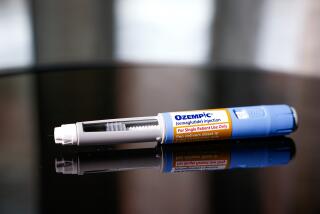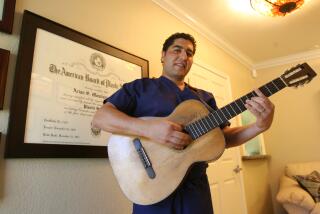Behind those lap-band ads
- Share via
One feature of life in Southern California that’s become hard to avoid is the relentless advertising for a weight-loss procedure known as lap-band surgery.
You’ve probably seen the billboards: They feature a willowy blond in a red tank top and the phone number 1-800-GET-THIN in huge red letters. “LOSE WEIGHT WITH THE LAP-BAND!” they say.
These billboards blanket Southland freeways like a giant adipose layer. I’ve counted 17 on one four-mile stretch of Interstate 5 east of downtown Los Angeles. The ads also appear on the sides of city buses, and there’s a TV spot with a jingle (“Let your newww life begin/Call 1-800-GET-SLIM”) I can’t get out of my head, curse it. (The two 800 numbers connect to the same place.)
The ads say the procedure takes an hour, as if you can pop in for a lap-band during your lunch break. In fact, surgically implanting the device requires a general anesthetic and three to four hours of recovery time. Doctors say you can’t resume normal eating for up to six weeks. Nor do the billboards mention the price: $18,000.
The lap-band campaign seems to be some kind of marketing watershed -- I’ve never seen anything promoted so ferociously on the L.A. freeways. But is it promoting good medicine?
Good question. Let’s take a peek behind the billboards.
The billboards advertise Weight Loss Centers, part of a Beverly Hills medical partnership called TopSurgeons. At least one website associated with TopSurgeons says the entity is “owned and operated” by the brothers Julian and Michael Omidi. (Julian Omidi refused to answer my questions last week about his role in the partnership, and other representatives of TopSurgeons refused to confirm the Omidis’ ownership. Michael didn’t return my calls.)
The Iranian-born Omidis built up high-profile practices in dermatology and cosmetic surgery after receiving their medical licenses in 2000 (Julian) and 2003 (Michael). TopSurgeons currently boasts 11 offices staffed by a total of 11 doctors and other professionals, according to the practice’s website.
In 2005, the brothers were featured on the plastic surgery reality show “Dr. 90210” on the E! cable channel, which described them in a press release as “immigrants who have built their multimillion-dollar surgical empire from nothing, and whose mother is in charge of all their business decisions.”
Today that press release would have to identify Julian Omidi as a former doctor. His license was revoked in 2009 by the Medical Board of California, which concluded that he had been intentionally deceitful on his license application.
Omidi had failed to mention that he had attended UC Irvine from 1986 to 1990. The board concluded that he did so “most likely” to keep it from learning that he had been expelled from UCI in 1990 for his alleged involvement in the burglary of exam papers. This and other factors led the board to conclude in its June 19 decision that Omidi has “a penchant for dishonesty.”
As for Michael Omidi, the medical board placed him on three years’ probation in 2008 after accusing him of being “grossly negligent” in treating three liposuction patients in 2005. The board said he administered anesthetics improperly and allowed unlicensed assistants to administer anesthetics, suture patients and even once to perform liposuction.
It’s unclear when TopSurgeons started pushing lap-band surgery. But in December 2008 it issued a press release touting the device and its “finest staff of Weight Loss Surgeons.”
In the right hands the lap-band, also known as a gastric band, is an effective obesity treatment. A silicon ring that constricts the upper part of the stomach, it works by making patients feel full after only a small meal, so they’ll stop eating. One study says patients can take off 50 to 70 pounds over two years.
But medical guidelines endorsed by the National Institutes of Health say the prime candidates for the lap-band are morbidly obese patients, defined as those with a body mass index -- a comparison of weight and height -- of 40 and above. (A 5-foot-10 person would register a 40 BMI at 279 pounds, or about 100 pounds overweight.) Patients with a BMI of 35 (244 pounds for our 5-10 subject) would be candidates if they also had weight-related conditions such as diabetes.
According to guidelines issued by a medical panel sponsored by the American Society for Metabolic and Bariatric Surgery (bariatrics is the branch of medicine concerned with obesity), patients should first try nonsurgical weight-loss programs such as Weight Watchers. “They come to surgery not as the first resort, but the last resort,” Dr. Namir Katkhouda, a nationally recognized bariatrics expert at USC’s Keck School of Medicine, told me. Because the surgery carries risks and has long-term lifestyle consequences, “it’s not a cosmetic procedure or a quick fix,” he says.
The guidelines from the metabolic and bariatric surgery group also call for a psychological exam of candidates to screen out those with depression, bulimia or personality disorders that might undermine the treatment. They don’t say anything about people inclined to choose their doctors from a freeway billboard or off the side of a bus, but that’s a new phenomenon and the guidelines were last updated in 2004.
The patient selection principles of TopSurgeons seem to be rather liberal. Its website says it “can help those with a BMI of 27 or greater.” (For our 5-10 patient, that’s a threshold of 188 pounds.) While the bariatric field is beginning to loosen its standards because of the nationwide epidemic of obesity and related health problems, that’s a broader patient selection model than anything I could find in the professional literature.
TopSurgeons says on its website that lap-band surgery can be covered by “most major insurance companies.” When I asked Blue Shield and UnitedHealth for their coverage rules, both told me they rely on the 35/40 BMI standard.
For other customers, TopSurgeons offers a different solution: Put the bill on a credit card -- specifically the Care Credit card offered by a unit of General Electric Co., which carries an annual interest rate for TopSurgeon patients of 13.9%.
According to Nancy Wambaa, a 51-year-old Los Angeles woman, TopSurgeons “encouraged” her during an office visit last year to fill out an application for the card just to check her credit. A full-time student and Medi-Cal enrollee, she was surprised to be told within hours that she’d been approved, and even more surprised a month later to get a bill for $15,000 from GE, even though she had told TopSurgeons that on her doctor’s advice she had decided against the surgery.
TopSurgeons eventually refunded $12,000 but kept $3,000 as a “cancellation fee.” She sued the Omidi brothers in state court Aug. 20, 2009, alleging breach of contract, breach of fiduciary duty and violation of the state consumer protection law. The court file indicates that they never answered her lawsuit, and in December she won a default judgment for the money.
TopSurgeons, for its part, has sued several lap-band patients for as much as $111,000 for their procedures. Most of the cases haven’t been resolved. A Top Surgeons “administrator,” Thomas Cloud (also a former doctor with a revoked license), said in an interview that the bills were so high because they also covered certain preoperative services and counseling programs. But if that’s so it isn’t reflected in the itemized accounts listed in the legal complaints.
It’s your call on whether to get a lap-band, and on who should do the procedure. But at least now you know more than the billboards told you.
Michael Hiltzik’s column appears Sundays and Wednesdays. Reach him at [email protected], read past columns at www.latimes.com/hiltzik, and follow @latimeshiltzik on Twitter.



